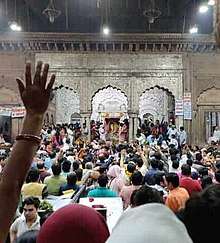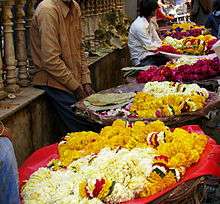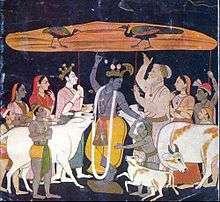Banke Bihari Temple
Shri Bankey Bihari Mandir is a Hindu temple dedicated to Lord Krishna, in the holy city of Vrindavan in the Mathura district of Uttar Pradesh. It is situated near Shri Radha Vallabha Temple. Bankey Bihari Ji was originally worshipped at Nidhivana. Bankey means "bent in three places" and Bihari means "enjoyer"
| Shri Bankey Bihari Mandir | |
|---|---|
बांके बिहारी मंदिर, वृंदावन | |
Shri Bankey Bihari Temple Main Gate | |
| Religion | |
| Affiliation | Hinduism |
| District | Mathura |
| Deity | Bankey Bihari Ji |
| Location | |
| Location | Vrindavan |
| State | Uttar Pradesh |
| Country | India |
 Location in Uttar Pradesh | |
| Geographic coordinates | 27.57976°N 77.69051°E |
| Architecture | |
| Type | Rajasthani |
| Completed | 1862[1] |
| Elevation | 169.77 m (557 ft) |
| Website | |
| http://www.bankeybihari.info | |
The image of Lord Krishna stands in the Tribhanga posture. Swami Haridas originally worshipped this devotional image under the name of Kunj-Bihari ("one who enjoys in the groves (kunj) of Vrindavan").
'Bānke' means 'bent', and 'Bihāri' or 'Vihāri' means 'enjoyer'. This is how Kṛṣṇa, who is bent in three places, got the name "Bānke Bihāri". According to Śrī Brahma-saḿhitā (verse 5.31), Lord Brahma says the following about Kṛṣṇa:
"I worship Govinda, the primeval Lord, round whose neck is swinging a garland of flowers beautified with the moon-locket, whose two hands are adorned with the flute and jewelled ornaments, who always revels in pastimes of love, whose graceful threefold-bending form of Śyāmasundara is eternally manifest." [2]
History
Bankey Bihari Temple was established by Swami Haridas (Lalita Sakhi in Dvapara Yuga),[3] a guru of the famous singer Tansen. Once on the request of his disciples Swami Haridas ji sang the following verse in Nidhivan in Vrindavan "Mai ri sahaj jori pragat bhai ju rang ki gaur syam ghan damini jaisen. Pratham hun ahuti ab hun aagen hun rahihai na tarihai taisain.. Ang ang ki ujraii sugharaii chaturaii sunderta aisain.. Shri Haridas ke swami syama kunjbihari sam vais vaisain.." On singing the verse, the Celestial couple Shyama-Shyam (Radha Krishna) appeared in front of him and his devotees. On the request of Shri Swami ji the couple merged into one and the idol of Banke Bihari appeared there (the same idol seen in the temple). The idol was established in Nidhivan.
The image of Bihariji installed in Shri Bankey Bihari Mandir is the one granted to Swami Haridas by the celestial couple Shyama-Shyam themselves. Submitting to the desire of devotees, The Lord appeared in person with his divine consort and left-back a black charming image before disappearing.
Swami Haridas was born to Shri Ashudhir and his wife Srimati Gangadevi on the day of Radha Ashtami i.e. eighth day of second (bright) fortnight of Bhadrapad month of the year 1535 Vikrami (1478 A.D.). He was born in a small village, now known as Haridaspur, near Aligarh in Uttar Pradesh. The lineage of the family can be traced back to Shri Gargacharya. Shri Gargachrya was the Kulaguru (family guru) of Yadavas and visited Brij secretly for conducting the Namakarana Samskara (naming ceremony) of young Krishna and Balarama on request of Sri Vasudeva. A branch of the family migrated to Multan (now in Pakistan), but some of them returned after a long time. Sri Ashudhir was one such migrant who after returning from Multan settled at the outskirts of Brij, near Aligarh.
Swami Haridas was the reincarnation of Lalita ‘sakhi’ (female friend), of the inner consortium of Lord Krishna. This easily explains the fact that even in his childhood, he was more into meditation and scriptures, while other children of his age were busy playing. He was married at the suitable age according to the time to Harimati. Even after his marriage, young Haridas stayed away from worldly pleasures and concentrated on meditation. Harimatiji was such a saintly soul herself that on realizing the inclination of her husband, she prayed intensely and was bodily transported to the heavenly abode of Lord by entering the flame of a small lamp in the presence of Haridas. No physical remains were left behind.
Soon after that Haridas left his village for Vrindavan, which was a dense forest at that time and chose a secluded spot, which is now known as Nidhivan, to practice his music and to enjoy eternal bliss of meditation. He constantly and continuously meditated on Nitya Ras and Nitya Bihar of Lord at Nitya Vrindavan. His way of Sadhna was to compose and sing songs in the praise of Lord. While on earth, living in a mortal state, he facilitated his regular unobstructed entry in the Nitya Bihar and always enjoyed the pleasure of closeness of Lord. He chose a secluded and densely forested area, Kunj, in Nidhivan as his gateway to the nirvana and was mostly sitting there, singing, meditating and surfing in the ocean of eternal bliss.
His disciples were curious about this place and one day with permission of Swamiji, they all entered the kunj. But instead of seeing anything they were almost blinded by bright, intense light, which seemed to fill the whole place. On knowing of their plight Swamiji himself went there, and then after his requests, the lord appeared in person with his divine consort, pleasantly smiling and in a playful mood and casting a spell of charm on every living being present there. Those who witnessed this, were so spell bounded by the beauty of the Lord and his consort, that they couldn't even blink their eyes; it seemed that all of them had turned into stone statues.

The legend as handed down to the generations of Goswamis, says that the beauty of the divine couple was such that no one wanted to lose the sight and proximity of divinity, but then what kind of divinity is it, which cannot make a mere mortal swoon and charmed enough to forget and give up the world and its luxuries? The beauty of the divine couple was so much that lesser mortals, like you and me, won't be able to bear such a heavenly beauty. Sensing this Swami Haridasji requested both of them to take a single form, as the world won't be able to bear their image. He requested them to take a single form like Ghan (cloud) and Damini (lightning), thus giving a perfect metaphor to the combined beauty of dark Lord and his fair consort, Radhaji.
Also he wanted his beloved lord to be in front of his eyes always. Granting him his both wishes, the couple turned itself into one single black charming idol, the same one that you see in the temple today. The charm and beauty of Shri Bankey Bihariji is the only reason why the ‘darshan’ in the temple is never continuous but is broken by the curtain drawn on him regularly. It is also said that if one stares long enough into the eyes of Shri Bankey Bihariji, the person would lose his self-consciousness.
Thus came into existence the physical form of Lord Bankey Bihari, popularly known as Bihariji. The responsibility of Sewa of Bihariji was handed over to Goswami Jagannath by Swamiji himself. Goswami Jagannath was one of the principal disciple and younger brother of Swamiji. By tradition, the Sewa is performed by descendants of Jagannath Goswami till day.
Initially, the deity was installed in a temple close to the first appearance in Nidhivan. A new temple befitting the glory of Bihariji was constructed in 1862 AD. Goswamis themselves mobilized resources for the construction. The temple is an architectural beauty in itself and follows the contemporary Rajasthani style.
The sewa of the Bihariji is unique in its own way. It is performed in three parts every day i.e. Shringar, Rajbhog and Shayan. While shringar (which includes bath, dressing and adornment with jewellery like crown and necklaces) and Rajbhog(feast) is offered in the forenoon, Shayan Sewa (shayan means sleep) is offered in the evening. The temple doesn't have a tradition of Mangala (early morning) sewa. Swami Haridas did not favour Mangla Sewa as he wanted his child like Lord to take complete rest and did not want to disturb him out of deep slumber so early in the morning.
So, the temple today stands with its full glory, inside which the Lord himself resides. It is thronged by thousands of visitors everyday.[4]
Rituals
During Jhulan Yatra, the swing festival of Lord Krishna, there are a number of silver-plated and some solid silver ornamented swings, which are shown at this time. The main day of Jhulan Yatra is the third day of the waxing moon, at which time Shri Bankey Bihari is placed on a golden swing (hindola). The curtain before the Deities is not left open like at other temples. Every few minutes, the curtain is pulled shut and then opened again. It is said that the brilliant eyes of Shri Bankey Bihari will make one unconscious if seen for too long a stretch. It is the only temple where loud temple bells are not used to wake Krishna in the morning. It is believed improper to wake a child with a start. He is woken gently. There are thus no bells even for Aarti, as it might disturb Him.[5]
The Deities do not get up until 9 am, because it is believed that Bankey Bihari ji has been up until late at night sporting. Mangala-arati is only one day a year in this temple, on Janmasthami. Only one day a year can the lotus feet of the Deity be seen, on Akshaya Tritiya (Chandan Darshan or Dolotsav), on the third day of the bright half of the month of Vaishaka (April–May). The autumn full moon day is the only day that the Deity holds a flute, and also on this day He wears a special mukut (crown). Shri Bankey Bihari comes off his altar and can be seen in full view on the last five days of the month of Phalguna, during the Holi festival. He can be seen with four gopis, who are seen just at this time.
How to reach
By Road : Vrindavan is situated on Delhi-Agra NH-2. the various buses runs between the Agra and Delhi. temple is 7 km. away from National Highway. Getting to Temple is very easy as there are frequent tempos and rickshaw available throughout the day. Mathura is just 12 km away. frequent buses, tempos and taxies runs between Mathura and Vrindavan.Another new way is from Greater Noida (Delhi NCR) TO Vrindavan via Yamuna Expressway
By Train : The major railway station nearby is Mathura on the Delhi-Chennai and Delhi-Mumbai main line. Several express and passenger trains connect Mathura from other major cities of India like Delhi, Mumbai, Pune, Chennai, Bangalore, Hyderabad, Calcutta, Gwalior, Dehradun, Indore, and Agra. Though Vrindavan itself is a railway station. A rail bus runs between Vrindavan and Mathura 5 round in a day.
By Air : The nearest airport is Agra just 67 km away from Vrindavan. The nearest international airport is Delhi, which is connected to almost every important city in the world with major airlines. There are regular flights to other important tourist destinations of India such as Delhi, Mumbai, Bangalore, and Chennai etc.
Schedule
- Summers: The temple opens around 7 am and aarti happens between 7:45 and 8:00am. Darshan is at 12 noon and in evening 5:30 to 9:30 pm.
- Winter: Darshan is 8:45 am to 1 pm, 4:30 pm to 8:30 pm, and all the time in your heart.
- all time darshan: darshan time is 8.45 am to 1pm and 4.30pm to 8.30pm through out the year.
Gallery
- Bihari ji ki gali, outside Banke bihari temple
- Nidhivana
- Bankebihari temple gate, sideview
 Garland sellers outside Banke Bihari Temple, Vrindavan
Garland sellers outside Banke Bihari Temple, Vrindavan
See also
- Radha-vallabha
- Prem Mandir Vrindavan
- Vrindavan Chandrodaya Mandir
- Krishna Balaram Mandir
- Radha Raman Temple
- Govardhan hill
- Radha Krishna
- Six Goswamis of Vrindavan
- Svayam bhagavan
- Brindaban Society
- Gaura Kisora dasa Babaji
- Hare Krishna
References
| Wikimedia Commons has media related to Banke Bihari Temple. |
- Glory project of Bihar, ISKCON PATNA, developed by Mahesh K Sanatan. "Temple History & Bihari Ji Appearance in Nidhivan - Shri Shri Banke Bihari, Vrindavan Dham". www.bankeybihari.info. Retrieved 9 June 2017.CS1 maint: multiple names: authors list (link)
- pnd (1 January 2012). "Bs 5.31". www.vedabase.com. Retrieved 9 June 2017.
- https://www.bihariji.org
- http://www.amritapuri.org/63578/16-bbihari.aum/gallery/thumbnails
- Sharma, Anisha. "Shree Bankey Bihari ji Maharaj, vrindavan Prince of Vrindavan: Shree Bankey Bihari ji Maharaj". AnandWay.com. Retrieved 16 July 2011.

